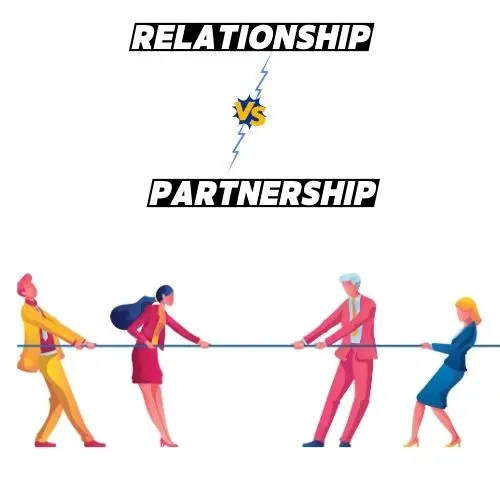Introduction
Relationships and partnerships are two common ways people connect and share their lives with others. However, some key differences between the two are essential to understand. This article will examine the differences between relationships and partnerships and provide insights to help you determine which you have or want to build with someone.
Critical Differences Between Relationships and Partnerships
Here is an overview of some of the main differences between relationships and partnerships:
Formality
- Relationships are informal connections based primarily on emotions, chemistry, and attraction.
- Partnerships are more formal agreements that outline roles, responsibilities, and expectations.
Commitment Level
- Relationships may involve varying levels of commitment, from casual dating to serious lifelong partnerships.
- Partnerships require a higher level of commitment to mutual goals, responsibilities, and the partnership itself.
Focus
- Relationships focus on emotional and physical intimate connections between individuals.
- Partnerships focus on working together to achieve common goals and interests.
Success Factors
- Relationships require compatibility, chemistry, and attraction between individuals.
- Partnerships depend on shared values, complementarity of skills, and commitment to the joint effort.
Legal Standing
- Relationships generally have no legal standing unless formalized through marriage.
- Partnerships are often legally recognized entities with formal agreements and rights/responsibilities.
Decision Making
- Relationship decisions privilege the needs and preferences of the individuals involved.
- Partnership decisions aim to serve the best interests of the partnership as a whole.
Conflict Resolution
- Relationships resolve conflict through compromise focused on individual needs and happiness.
- Partnerships manage conflict through open communication based on mutual benefit & shared goals.
| Key Factor | Relationship | Partnership |
|---|---|---|
| Purpose | Intimate connections | Achieve shared goals |
| Structure | Informal | Formal agreement |
| Commitment Level | Varies | High |
| Success Factors | Compatibility, chemistry | Shared values, complementarity |
| Legal Standing | None usually | Often a formal entity |
| Decision Making | Focus on individual | Focus on partnership |
| Conflict Resolution | Compromise based on individual needs | Communication based on mutual benefit |
Insights on Relationships vs Partnerships

Keep these key insights in mind when it comes to differentiating between relationships and partnerships:
Relationships are connections focused on affection, attraction, and intimacy between individuals. They bring joy, companionship, and comfort to our lives through casual dating, committed partnerships, platonic friendships, and family bonds. Relationships thrive when there is natural chemistry and compatibility between individuals.
Partnerships are focused on collaborating to achieve shared interests and goals. They allow people to combine their strengths and work productively through formal or informal agreements. Partnerships thrive with clear expectations, open communication, and a shared commitment to mutual objectives.
Ask yourself what the primary focus is. Is it to create an intimate, emotionally fulfilling connection between individuals? Or is it to collaborate and accomplish something you cannot do alone? This can help determine if you are forming a relationship or a partnership with someone.
Partnerships often formalize relationships, but the reverse is not always true. Many close personal relationships can evolve into formal partnerships through marriage or business agreements. However, partnerships aren’t always predicated on pre-existing intimate relationships. Think of any co-owners of a business.
Both relationships and partnerships require compromise but of different priorities. Relationships prioritize the individual’s happiness, while partnerships prioritize the health and objectives of the partnership entity, which requires more sacrifice.
Communication and conflict resolution must align with the nature of the connection. Relationships take a compromise approach, focusing on emotional needs. Partnerships require open communication focused on mutual benefit rather than individual preferences.
There are no inherently “right” or “wrong” structures. Each serves different primary purposes. To ensure alignment, the key is to be clear about what kind of connection you want or have with someone else.
Balance is ideal. The most satisfying relationships often have an element of partnership, and the most effective partnerships have some degree of relationship and emotional connection between the individuals involved.
Steps to Determine if You Have a Relationship or Partnership

Follow these steps when assessing any interpersonal connection to determine if it’s a relationship, partnership, or blend of the two:
Step 1: Consider the origin and history of the connection. Did it arise from romance, chemistry, and emotional bonds? Or through a pragmatic agreement to achieve something together? This can reveal if the foundation leans more toward relationships or partnerships.
Step 2: Analyze the main focus and priority of the connection. Are conversations and activities centered on emotional intimacy and affection? Or achieving mutual goals and interests? What seems to take precedence most of the time?
Step 3: Discuss openly the type of commitment and expectations involved. Is this an informal connection that can be ended at any time? Or a formalized agreement with binding expectations?
Step 4: Pay attention to the language and terminology used. Do you refer to yourselves as partners? Does it feel more like a personal relationship? The language employed often conveys the true nature of a connection.
Step 5: Consider your conflict resolution and decision-making patterns. Do you prioritize each individual’s needs and happiness? Or focus on mutual benefit and partnership objectives? Observe how conflicts get resolved.
Step 6: Reflect on the legal standing and formality of the arrangement. Is there a business partnership agreement involved? Shared accounts or property? Legal designations like marriage? Formality usually signals a partnership.
Step 7: Evaluate the balance and degree of overlap. Most connections contain aspects of both relationships and partnerships. Determining the overall balance and intersection can clarify the nature of the bond.
Conclusion
Understanding the critical differences between relationships and partnerships allows us to be more intentional about the connections we form in life. Consider what kind of bond you want to establish and proactively structure it accordingly. Seek out compatibility for fulfilling relationships. Define shared goals and expectations for effective partnerships. Keep communicating openly, especially when evolving from one form to another.
By examining the unique focus, success factors, and communication patterns of relationships versus partnerships, we can set ourselves up for more satisfying and productive bonds with the people in our lives. With intention and effort, we can build connections that enrich our lives emotionally while working together towards common goals and interests.

